In the movie “Remember the Titans,” Coach Boone is the new head football coach of the first integrated school in Virginia. The school staff and parents immediately begin criticizing him. As they are preparing to leave for pre-season camp, Boone is carrying his playbook—a very thin portfolio of plays.
Assistant Coach: “Awful skinny playbook in’t it?”
Coach Boone: “Well, I run six plays, split veer, it’s like Novocaine; just give it time, it always works.”
Similar to Coach Boone’s playbook, Novocaine Training is simply a series of training sessions that can be cycled through as fast as can be recovered from. The benefit is the consistent prioritization of the needs of a tactical athlete.
Background
I was never a gifted athlete. In fact, I was almost always the slowest, heaviest, and weakest relative to other athletes. But what I lacked in talent, I made up for with heart and work ethic. When I first joined the US Navy’s special operations community, I could barely keep up. I was over 200 pounds, slow, and weak. Over time, consistent training made me slightly better than average in the community. While I was only mediocre, the relative improvement was far greater than those who started with more advantage. Fast forward 20 years and I have been from poor fitness to excellent fitness, to injury, back to poor fitness, and back to excellent fitness again enough to significantly exceed the standards for my current role in federal law enforcement. The point is that I have made tremendous relative improvements multiple times. A few lessons have been ever present during all the times of improvement:
Logistics
Successful training has to be accessible. We don’t all have fully outfitted gyms. We can’t always do a superset of 50 swim sprints with three back squats at 80% of one-rep-max. Days need to be focused on a single location that has the equipment needed. Segregating strength days from track days makes the logistics of accessing the training obtainable.
The schedule of a tactical athlete can be very sporadic. A strict weekly schedule has almost never worked for me. I miss days because of operations, family obligations, stress, etc. A successful program needs to be flexible.
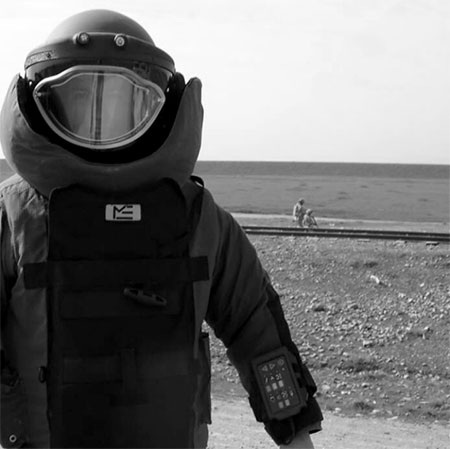
It is also important to be able to modify the intensity of training depending on recovery status and phase of training. For most day-to-day operations, a certain level of fitness is required but at times that need changes. Whether preparing for a fitness test, screening for a specialty job, or preparing for selection course, there are times when the intensity of training needs to increase or, at least, can increase if time allows.
Prioritize
Some attributes are more important than others. Aerobic capacity is hands down the most important attribute for the tactical athlete. As a person paid to be able to perform physically, there are capabilities that I must have to accomplish the mission. The most common need I have encountered as a tactical athlete is the ability to work long days or multiple days in a row. Responding to days on end of a crisis operation requires aerobic capacity to continually fuel and recover. For example, consider those responding to the Boston Marathon bombing. They needed the ability to carry victims to safety repeatedly, recover and then work long hours searching for the subjects. Or 9/11, being able to move debris and carry victims for multiple days and not run out of gas. Operation Phantom Fury required living out of a pack going door to door from dawn to dusk for multiple weeks.
Additional capabilities likely include wearing heavy protective equipment, carrying packs, wrestling subjects, climbing ladders, and more. Lastly, some activities simply require going very hard for as long as possible such as a long dive against a strong current or grappling for your life.
In all these circumstances, I can’t imagine that more strength would not help.
Durability
I have sustained multiple shoulder injuries, a fractured pelvis, multiple knee injuries, and multiple herniated discs. The saying, he who lifts the longest gets the strongest is very insightful. Staying injury free allows continued progress. More importantly, staying injury free prevents a person from becoming a liability to their team. Nobody wants to be the person who can’t help because they are broken. Additionally, when a job requires a need for physicality, not being able to perform is a non-starter. As we age, we need more time to recover. As we increase the training difficulty, we need more recovery time too.
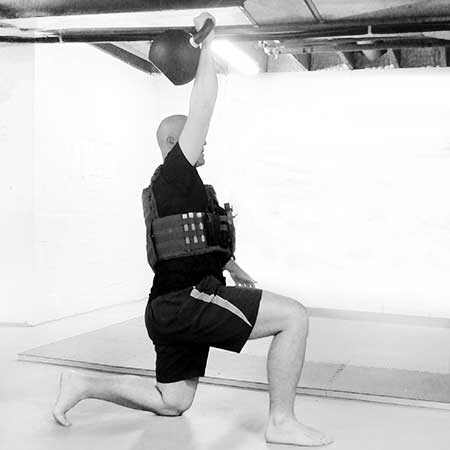
By placing the focus on training as a list maximizes the flexibility necessary too. Training could be performed anywhere from three to seven days per week depending on an individual’s logistical constraints. The real advantage to this kind of training is its modular nature. There is a suggested base for the training session and depending on individual needs, add additional training to the appropriate days. One could rotate between strength and endurance focused cycles or follow one exclusively. For something like a screen test or selection prep, performing both supplements might be necessary, and the session may need to be broken up into AM and PM sessions just due to time constraints.
The Program
Novocaine Training can be done seven days a week if it works with your schedule and current physical capabilities, but the minimum dose is to train the base sessions three times per week. You can then add either supplement option A or B in cycles or exclusively if desired. For peaking (if time allows) train both supplements. If you’re young and fresh in your career, you can probably train more frequently with more supplementation. If you’re later in your career, you may only want to train the base or train less frequently. Consider the seven sessions defined below as a template to work through in order. If, for example, three training sessions per week is best for you do sessions 1, 2, and 3 this week, 4, 5, and 6 next week, then 7, 1, and 2 the following week, etc.
Sample Schedule
There is no right or wrong schedule. Some weeks life is busy and we train very little, some weeks are light and we have both the time and motivation to train every day. I have trained seven days per week and I have trained one day per week and all that really matters is that I keep training. Obviously, the more often you are able to train and recover from it, the faster you will progress. As mentioned above, I suggest three times as a minimum per week.
Base Sessions
- S&S (swings and get-ups): I’ve found the get-up to be the most valuable movement mainly because of the phenomenal structural integrity it builds to protect against injury. The get-up has been critical to my rehabilitating multiple shoulder injuries and preventing worse or more frequent injury to such a vulnerable yet critical joint. I have also herniated multiple discs in my back and have found the swing to be excellent at building resilience for the back.
- Low Intensity Steady State (LISS): Any form of endurance activity works well for LISS exercise. Personal preference plays a large role for LISS. Some athletes need to ruck more, some need to ocean fin more, some need to run more. If you like recreational running with teammates, perhaps more running is the ticket. I have found the SkiErg to be an excellent fit because I can do it year-round in the basement and its low impact nature was helpful rehabbing multiple knee injuries.
- Q&D 033 (swings and pushups): The Q&D 033 works well if for no other reason than most fitness tests have a pushup element. The four sets of five reps every 30 seconds timing works great long term, and the two sets of ten on the minute timing works well to enhance the pushup portion popular on most employer mandated Physical Fitness Test (PFT) numbers.
- A+A (snatches): I have found that starting a set every 75 seconds balances intensity and recovery well for A+A. Snatches are often the preferred movement for A+A but I prefer to alternate snatches with something else like sprints, Airdyne, rower, SkiErg, etc. The SkiErg provides the most antagonistic movement to the snatch and I’ve found it to be my favorite. When I do snatches and the SkiErg for example, I will do five snatches left, rest the remaining of the 75 seconds, five SkiErg pulls, rest, five snatches right, rest, five SkiErg pulls; which would be four sets out of the 20 to 40 total sets.
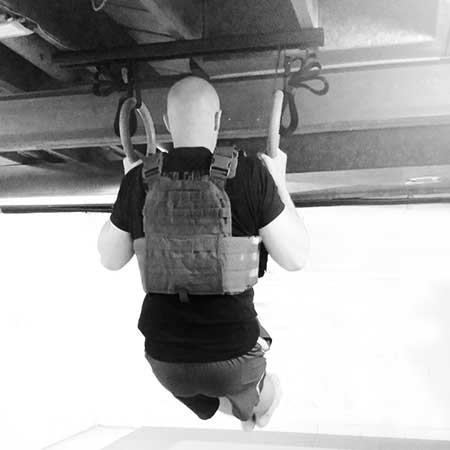
Supplement Sessions
- Strength supplementation: Pullups are critical to a tactical athlete whether it be for PFT scores, climbing caving ladders, etc. Any heavy pressing movement works for pressing. The overhead press is probably the most valuable, but I think the bench press has its place due to fitness tests having pushups and some having max rep bench press elements. I think the front squat is important for building leg strength and it is more quad dominant than something like the low bar back squat. And because of all the swings and snatches, I find low bar back squatting and even deadlifting may not be all that critical for supplementing the posterior chain. Accessory day is the day for whatever a person wants. Curls for the girls, whatever. Alternatively, StrongFirst’s Reload program fits the bill very well for strength supplementation. The two-day per week program using A and B sessions and with core and horizontal and vertical pulls for the accessory day.
- Endurance supplementation: Lactic threshold tempo sessions are probably the most valuable to improving performance. For high intensity repeat training (HIRT), the key is long rest. For something like running, repeats are about pace and not just going hard. These days could be shorter faster repeats like 400-600m repeats or longer intervals such as 800-1k. I have found Jack Daniels’ VDot pace calculators to work well for providing target paces. His book, Daniels’ Running Formula, provides recommendations for work to rest intervals depending on pace and total volume based on weekly mileage.
Rotate through a relatively small number of sessions, train as often as possible, and just show up and do the work. This simple approach to training yields profound results. It’s like Novocaine; just give it time, it always works.
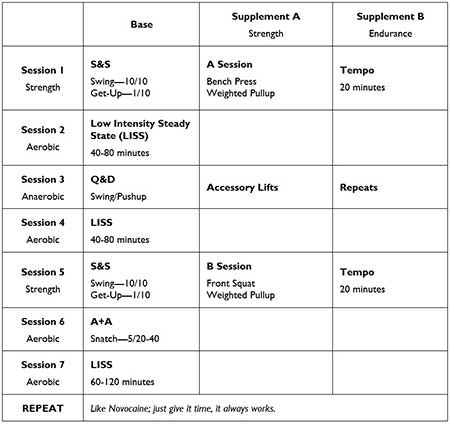
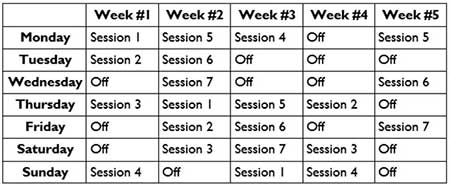
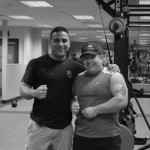
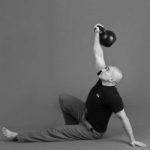
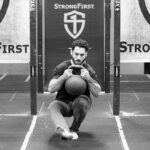


Late to the party here. But wondering if doing C&P as in The Giant instead of S&S would work? Appreciate any feedback.
Hello,
I wonder this too … what about RoP (C&P+pullups) instead S&S (swings+TGUs).
Thanks a lot !!!
I think the swing and TGU should be the focus on the base of the program. I think RoP or Giant fit better as the strength supplement if a person doesn’t have access to a barbell.
Hello Justin,
That is a very interesting article ! I started running this routine.
For the strength supplement, would it be interesting or worthy to do OVH press instead of BP ?I find this move very functional and utilitarian. I do not have a bench but I can do OAOLPU or OAP though.
For the LISS, is it possible to mix rucking and running ?
Thanks a lot !
Kind regards,
Notes: I do not prep for a selection and have Simple
Sorry for not checking in for so long. I think the strength supplement can be just about whatever a person wants if not training for a tactical PFT. I think the OH press is just fine. Also, any Naked Warrior concepts for the strength supplement would work just fine. The significant difference would be to get more volume in on those days instead of GTG and higher frequency.
Thanks for the interesting insights!
I thought Strongfirst is always against mixing different types of training methods and focusing on one method at a time.
That saying I’m surprised about combining Q&D,A+A and S&S into the same training cycle.
Are there any guidelines when combining is ok and when it is not?
best regards!
I don’t want to speak for StrongFirst but generally the recommendation to not train different types usually refers to combining endurance training and strength training as the adaptations can be conflicting. That said, cross training has been a thing for a very long time.
S&S, Q&D, and A+A are not really different adaptations as much as they are variations of the same adaptations.
My thoughts are that it is ok to combine when A) that’s the adaptation you need; or B) the adaptations are similar enough to not conflict with each other. The important distinction is the rate of progress will be different between the two; the former will take longer.
This is amazing, thank you for the thoughtful program.
I didn’t quite understand what “tempo” means for endurance training. Mind explaining?
Tempo is at/near lactate threshold heart rate or pace.
Allow me to second Justin’s recommendation of “Running Formula” by Jack Daniels. He will tell you, based on your recent bests, exactly the pace you should be running for your tempo runs.
S&S and kettlebell presses is doing it for me, keeping me strong and well in control of my balance for the combat sports I am involved in. Also, I walk a lot. Interesting that I have ended up doing by “feel” more or less exactly what you recommend. And, yes, I do some chinups too, haha!
Great article! Thank you for taking the time to share this program. I am intrigued by your use of the SkiErg & like that it’s low impact.
I use the SkiErg for just about anything. I like it for LISS as it is very easy to go very easy. When starting MAF training, it can be difficult to go eat enough. Also, I have a hard time staying on a seat of a bike or rower for extended durations and like to support my own bodyweight.
For tempo work, it’s also very good for utilizing the entire body and supporting ones own bodyweight.
For intervals, I like that it can go from 0 to 100 pretty well. Not quite as good as sprinting or an Airdyne but good enough.
Good stuff. I’m curious, if you took all the machines out of your programming how would you replace, say, the Ski? I train outdoors, with KBs and med balls, and really anything I can drag down to the park.
For LISS, I would ruck or run.
For A+A, I would swing, snatch, or sprint. Sprinting would be reps counted by same-side foot strikes. (I.e., start left foot forward, count each time the left foot strikes the ground as a rep. 5 reps equals 5 left foot strikes.)
I also really like sprints and pushups for Q&D sessions. I’ve done jumps of various kinds and prefer sprinting as an alternative to KB ballistics.
Hi Justin
In relation to S&S, are the full warmups and cooldowns (as per S&S book) intended to be included in your program. What warmups\cooldowns do you intend be included before the Q&D, A&A section of program? I look forward to hearing your thoughts ob
I don’t really warmup unless I’m sprinting or going over 80% with the barbell. It’s kind of a personal preference and individual need kind of thing though. I wouldn’t advise against them but I also don’t cheerlead for warmups for kettlebell work.
Outstanding article. Modular nature training program concept is top notch. Thank you for sharing your insights. You did not include much discussion of stretching for a tactical athlete, and I would be grateful if you could very briefly address to what extent you incorporate stretching into your training. Specifically, Pavel’s prescription in S&S is to begin each practice with three circuits of five reps of prying goblet squat, hip bridge and halo. Then after practice or before bed he says to do one to three circuits of 90/90 and QL straddle. Do you follow this guidance on days you do S&S, and do you consistently incorporate these stretches or others into or as a complement to your training program. I am especially interested in hearing your input as you have overcome many setbacks and managed to consistently perform at a very high level for a long time. Many thanks.
I do not do much stretching at all. I got into yoga for a little and it did make me feel good though. I like to do front squats with the barbell for hip/ankle mobility and I have used halos a lot for rehab but I don’t regularly do the warmup or stretching. All my injuries have been caused by pretty blunt trauma. All the guys I know that have taken a beating have mostly survived or minimized injury by having more muscle mass and being stronger. I’ve never felt that more mobility would have greatly helped.
All that said, I think I’m neglecting the long term benefit and not seeing the forest through the trees.
My kettle bells go back to Pavel’s arrival here. I have used the swing as my endurance foundation along with a climber and bike. At 78 i’m reconsidering including flexibbility exercises because one does NOT naturally become more limber with age ,(L.O.L.), ! But let me say that after a fractured C4&5, an artificial left hip and 2 hernias that TRAINING is the Best medicine. I only use eye drops for glaucoma. Because of K.Bs, B.B.s and HITT i’m blessed.
78 and still training! I thought I was doing well at 64. I want to be like you.
I think you should try Turkish get ups. They work great for both strength and mobility.
Great article! But I would like to ask if I can switch A+A Switch to Swings and in LISS session do some Loaded Carries?
Thanks.
Sure, I’ve done swings in place of snatches a lot. I really like heavier 2H swings the best.
LISS is just important to get the duration long enough at a low enough heart rate to drive the aerobic adaptation. If the carries are at an appropriate weight, it’s viable. I would probably prefer rucking so as not to be interfering with the strength work on the other days. Don’t turn every day into a high intensity day.
Thx Justin, that sounds reasonable, rucking gets a vote.
Would double kettlebell front squats be good for the strength work?
Yes. The idea is to supplement the base work but not replace the base work. Some strength programs are more suitable to use as supplements and others are not. A good rule of thumb is to do 2/3 the volume of a strength only plan if using it as a supplement.
Very recently retired from the Military myself and entered a career in law enforcement. Been struggle to find a balance with managing recovery while still making progress. At 40 it’s a challenge and I don’t think it’s a good idea to be sore for days while on patrol cause you went to hard during a workout. I like the look of this. Busy days I can do what’s needed, and days off I can push a little harder…thanks.
Injury history permitting, I’d probably include some fairly knee-extension-focused work if I expected to spend time carrying heavy things up and down steep hills. Front squat or RFESS or heavy step-ups or belt squats or something. In training cycles where I pretty much did one big pull, one big press, and LISS, my quads ended up being a noticeable weak point. (I usually go for a quaddier big pull these days too, trap bar from a deficit or snatch grip ditto.).
Solid otherwise.
Hey Justin, great article.
I’ve landed on a very similar strength protocol over the last 16 weeks…. targeting 300 swings a week split between 2-3 sessions alternating S&S style sets of 10 OH, 033, and A+A both in sets of 5. Supplemented with a few squats, TGU and some mobility work. It’s been very effective indeed.
I’ve been doing a lot of easy aerobic work 5-10 hours a week and have a reasonably insane work & family schedule so wanted a really simple low impact strength protocol.
There is no particular plan apart from hitting 300 or so swings a week. One week I ended up doing all 300 in one session on the Sunday, whereas last week it was 320 across four sessions.
I opted for swings rather than snatches for the Q&D and A+A because I’m training for an endurance event and add 5 lbs the moment I even think about snatching, even in sets of 5.
The S&S style sets are on 90 secs (as I’ve got older I’ve learnt that long breaks give better results for me), 033 per the protocol and A+A on the minute.
Danny
That sounds great Danny!
Daily Undulating Periodization (DUP) is really becoming more of the standard and S&S, Q&D, and A+A are a perfect example of ways to perform DUP with a single bell.
Glad you’re seeing good results with similar programming.
Question please, Justin…
How do you go about timing your 75 second sets during your A+A work? OTM sets are simple with any stop watch: on a double zero, go. Without doing a lot of on the fly math, 75 seconds does not lend itself to an intuitive cycle.
I understand your idea, and snatches travel twice as far as swings, so that extra quarter minute makes sense. How do you keep it up over time without losing you next start time?
Thanks.
I mostly the Impetus timer app on my phone. I have also used the split lap function on a watch.
Great article! The program checks all the boxes including variety to keep away that itch from occurring. I think this should also be considered a program to run forever.
Thanks for such a great article! I wish I had this info before I retired myself, would have made the last few years a bit better. Lol. Thanks again Justin
What is A+A, sorry dumb question.
A+A means Alactic + Aerobic. The protocols are used to target the alactic energy system using high intensity efforts lasting 7-12 seconds and then utilize the aerobic system to replenish the alactic energy system.